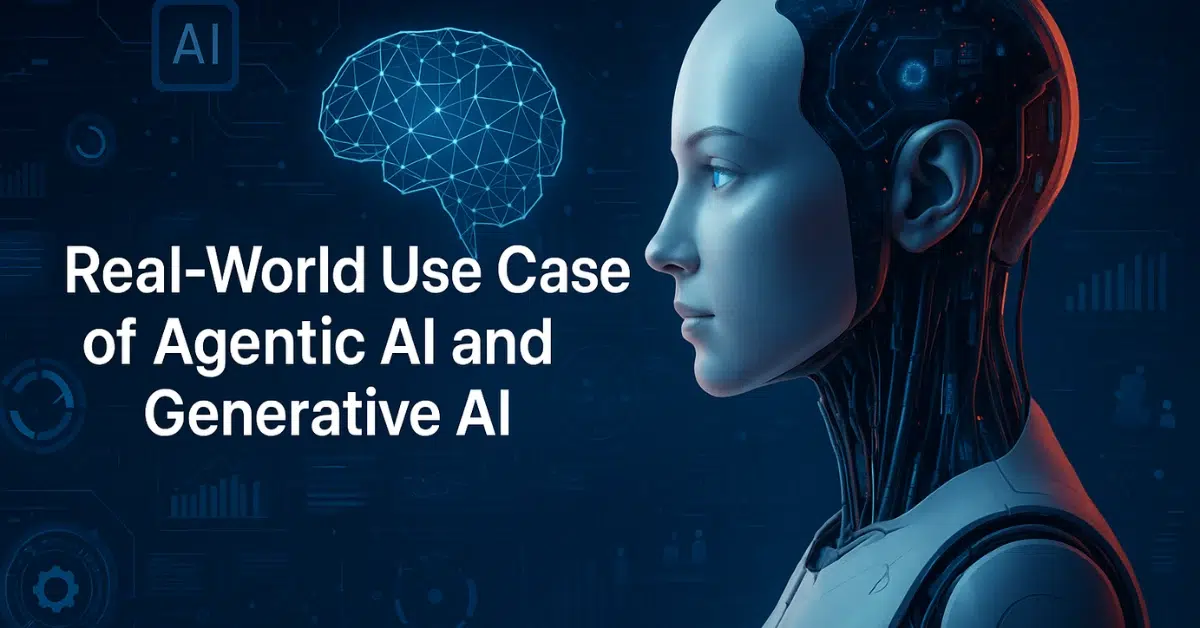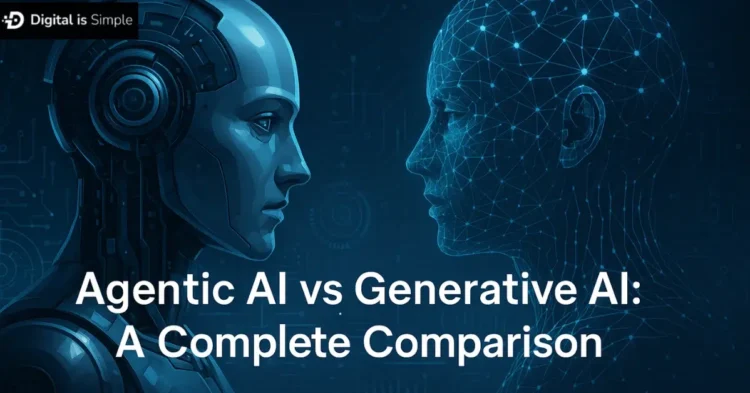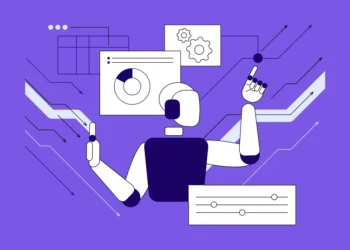You probably don’t know this yet, but there’s a new AI kid in town. Meet Agentic AI, a new subset of artificial intelligence. Agentic AI takes things a step further by planning carefully and acting on research, making it stand out in the Agentic AI vs Generative AI debate.
Unlike traditional AI tools that were released in late 2022, Agentic AI doesn’t solely rely on human prompts or oversight.
Agentic AI relies on natural language processing, machine learning, and large language models; it isn’t the same as a GenAI model.
In this article we will cover the differences between Agentic AI and Generative AI.
What is Agentic AI and Generative AI?
Agentic AI is described as AI systems that are designed to make decisions and pursue complex goals with limited supervision. Agentic AI uses a wide range of functions to solve complex problems, including:
- Code generation
- Software design
- Conversational assistance
- IT automation
Agentic AI builds on GenAI techniques by using large language models (LLM) to function in dynamic environments.
Some of the functions Agentic AI include:
- Decision-making
- Performing actions
- Interacting with external environments
- Problem solving
Generative AI or GenAI, on the other hand, can create original content based on the user’s prompt, such as:
- Images
- Text
- Video
- Audio
- Software Code
Generative AI relies on deep learning models (Like neural networks) and diffusion models to analyze large amounts of data and generate new outputs. These models can be trained over time.
Agentic AI vs Generative AI – How They Differ
Although there are similarities between these 2 models, Agentic AI specializes in workflow automation. Generative AI’s biggest strength lies in creating content. To make it easy for you to understand the differences, read the comparison table below:
| Agentic AI | Generative AI | |
| Core Function | Follows multiple steps to achieve a goal | Generates content based on the prompt |
| Task Functionality | Easily handles complex tasks such as researching, analysis, and reporting | Generating extensive research papers, drafting code for full applications |
| Autonomy | Can operate independently with little assistance. | Dependent on the instructions provided by the user. |
| Benefits | Tackles multifaceted problems | Speeds up content creation and answers simple questions. |
| Considerations | Requires clear goal definition and validating responses. | Requires careful prompting and fact-checking of the sources. |
How Agentic AI Works
The implementation process varies but usually consists of 3 main models. This includes:
1. Models
The “brain” that understands what you want and figures out how to do it step by step.
2. Tools
External programs or services the AI can use, like calculators, databases, or websites. There’s a new standard called MCP that helps connect AI to these tools.
3. Orchestration Layer
The “coordinator” that manages everything and decides which tools to use when. Popular frameworks like LangChain and CrewAI handle this coordination.
The developers will follow a similar process to build an AI Agent, and the process usually includes 4 steps:
1. Plan the Workflow
Figure out what tasks the agent needs to do and what steps are involved.
2. Choosing the Right Tools
Decide what external programs or services the agent will need to access.
3. Pick the AI Model
Select which AI “brain” (or combination of brains) will work best for the job.
4. Connect Everything
Use a framework to tie the model and tools together so they work as one system.
For Complex Projects- Break the work into smaller agents that each handle one specific task, like having different specialists work together on a team.
Real-World Use Cases of Both Models
 There are many use cases of Generative AI. However, for Agentic AI, the use cases are still in experimental mode. These use cases will help you understand the differences between Agentic vs Generative AI.
There are many use cases of Generative AI. However, for Agentic AI, the use cases are still in experimental mode. These use cases will help you understand the differences between Agentic vs Generative AI.
Agentic AI Use Cases
1. Customer Service
Customers are bound to ask specific questions about their order. Agentic AI models will read the situation and understand the intent of the query better than a traditional chatbot. Based on the interaction, Agent AI chatbots can take steps to quickly resolve the issue.
2. Financial Risk Management
Agentic AI models can help clients make smart decisions on their investments based on market trends and credit risks. These agents can monitor market fluctuations and suggest recommendations for your portfolio.
3. Workflow Management
From reordering supplies to managing supply chains, Agent AI can easily handle these complex tasks. Agentic AI can adjust delivery routes based on real-life traffic updates. This is one of the biggest differences between Agentic and Generative AI.
Generative AI Use Cases
1. Marketing and Sales
Businesses often rely on GenAI models like ChatGPT to improve their sales strategy and assist in generating more sales. These tools will break down the process and tell you how you can improve.
2. Content Creation for SEO
Another difference between Generative AI vs Agentic AI is the creation of content. GenAI models can quickly generate large volumes of data, driving organic traffic. Additionally, finding relevant keywords and trending topics also becomes easier with GenAI.
3. Design Concepts
Gen AI capabilities also lie in generating high-quality designs based on market trends and user preferences. This helps in speeding up the development process and making changes as per customer feedback.
5 Types of Agentic AI Explained
Since we want to know more about Agentic AIs, we will be covering the 5 most common types of Agentic AIs:
1. Simple Reflex Agentic AI
The most basic type of Agentic AI follows rules based on environmental conditions. They usually follow preset rules known as condition-action rules. It’s most effective when rules are well-defined.
For example: A thermostat is a simple reflex agent that turns on the heater if the temperature drops below a certain temperature. It’ll automatically turn off when the desired temperature is reached.
2. Model-Based Agentic AI
This is a slightly more advanced model than a simple reflex model. This system makes decisions based on pre-programmed rules but with memory of what is happening around it. It remembers what is being done previously and what it did and hence makes more intelligent decisions.
For example: A robot will navigate its path around obstacles based on the previous experience it had. They can handle situations where context needs to be remembered and used for future decisions.
3. Goal-Based Agents
Goal-based Agentic AI don’t just react to what’s happening right now – they think about what they’re trying to achieve and plan to reach their goals.
For example: A robot trying to get to a specific room won’t just avoid whatever obstacle is right in front of it. Instead, it will plan the best route from the start, thinking about all the obstacles it knows about and choosing the path that gets it there most efficiently.
4. Utility-Based Agents
These types of agents will consider the possible outcomes to achieve a certain goal. They’ll assign a utility value to each, helping them choose the best possible outcome.
For example: A self-driving car may choose a route that optimizes fuel instead of choosing the fast-paced lane.
5. Learning Agents
Unlike the other agents mentioned above, learning agents are constantly updating their outcomes based on behavior and feedback. This allows them to improve their decision-making skills and perform better in unpredictable situations.
Learning agents have 4 stages:
- Performance: Making decisions based on knowledge
- Learning: Adjusting the outcome based on feedback.
- Critic: Evaluating the models’ performance and providing feedback in the form of rewards and points.
- Problem Generator: Suggests recommendations in improving their strategies and learning capabilities.
For example: In reinforcement learning, an AI agent tries different approaches and gets rewarded for doing things right or penalized for doing things wrong. Over time, it figures out which actions work best and gets better at its job.
Top 3 Workflow Benefits of Each
By now, we have a good understanding of the basics of Agentic AI and GenAI models. Each has its own strength in terms of productivity and saving time. Here are the top 3 benefits of each:
GenAI Workflow Benefits:
- Produce high-quality reports within minutes.
- Summarize large volumes of texts into bite-sized insights.
- Provide alternative solutions for a problem.
Agentic AI Workflow Benefits:
- Maintain consistent application of rules and compliance requirements.
- Coordinate and manage multiple tasks and tools.
- Reduce the time to complete complex tasks through autonomous decision-making.
Upcoming Trends in Agentic and Generative AI
As we move ahead in the future, it’s important to be aware of the upcoming trends in Agentic AI and GenAI models. Here’s what you should look out for:
GenAI model
1. Synthetic Data for Model Training
The use of synthetic data can improve the outcomes a GenAI model gives. This will be beneficial for companies in the robotics, autonomous, and finance sectors.
2. Content Personalization
Marketing teams can benefit by adapting content and campaigns to individual preferences and making online shopping memorable.
3. Augmented Applications
User experience will become hyper-realistic and provide intelligent solutions to consumers.
Agentic AI Trends
1. Human Resources
Agentic AI can automate tasks and provide personalized responses to employees. This will allow the team to prioritize more important tasks.
2. City Planning
AI can enable city managers to take better decisions by processing diverse forms of data, such as traffic flows and videos from cameras.
3. Robotics
Firms like Amazon started making use of robots at their warehouse so that automation and manufacturing can run smoother.
If you need more information about these trends, contact an custom AI development company. Their experts can give you a consultation based on your requirements.
Risks and Challenges of Agentic and Generative AI
While Agentic AI has multiple benefits to offer, there are challenges that come with it.
1. Data Privacy
If not handled properly, your confidential information can be accessed by hackers for illegal purposes. Therefore, follow security protocols to ensure your data stays secure.
2. Infinite Feedback Loops
Agentic AI that can’t learn from what they’ve done might get stuck doing the same thing repeatedly in an endless loop. To prevent this problem, humans sometimes need to watch and step in when needed.
3. Computational Complexity
Building Agentic AI from the ground up takes a lot of time and computer power. Training a good AI agent requires significant resources.
Wrapping Up
When we look at Agentic AI vs Generative AI, the differences become clear, helping us understand how each plays a distinct role in the evolving AI landscape.
But also, it’s important to keep in mind the challenges it brings to the table. Ensure that you’re taking the necessary precautions to keep your information safe and train it every now and then.
Frequently Asked Questions
Q1. What’s the difference between a chatbot and agentic AI?
Here are the top 3 differences:
- Agentic AI takes multiple steps to make decisions and learn independently. A chatbot makes decisions based on the inputs (or prompts) given by the user.
- Chatbots are used more for repetitive tasks and agentic AI helps in executing complex tasks.
- Chatbots operate on scripts, and Agentic AI evolves based on real-time data and results.
Q2. What’s the difference between Generative AI vs Agentic AI?
Even though they’re similar, Generative AI and Agentic AI are different from each other. Here’s how:
- Generative AI: Focuses on creating content like images and texts from prompts.
- Agentic AI: Makes goal-oriented decisions to solve difficult problems.
Q3. Is ChatGPT Agentic?
Yes! By itself, ChatGPT is Generative AI. But when combined with external tools and reasoning tools (like browsing or using APIs), it can behave in an Agentic way.
Q4. What’s the difference between AI and GenAI?
AI is a broader field that can mimic human intelligence for tasks like pattern recognition. Generative AI (GenAI) is a subset of AI that is used for generating new content like texts and images.
Q5. What are the use cases of Agentic and Generative AI?
Use cases of Agentic AI include:
- Self-driving cars that use sensor data for navigation
- Siri, Google Assistant, and Alexa for managing tasks and learning preferences.
- Thermostats can help you reduce the energy consumption of your home.
Use cases of Generative AI include:
- SEO and content creation
- Marketing and Sales
- Design and Development

















